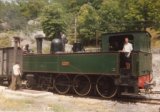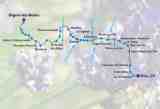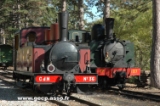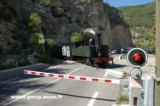

| site search byfreefind | |||
|
|||
Chemin de Fer de Provence (French)
ProvEnce Railway (English)
Nickname: “Pigne” (Pine Nut) Railway
The author in the cab ready (in his dreams!!!) to drive the train
Written by Philip Schram
Pigne? What is “pigne”? Pine nuts are small seeds that grow inside
the pine cone coming from the pine tree. Pine nuts are delicious to
eat. There is a legend that the railway used to burn pine cones in
the firebox of locomotives.
Provence is the French region which is the most likely to catch the
travelers’ imagination. Provence relates to waterfront, nice
landscape, outstanding weather, vacation, long summer times,
lavender fields and the impressionist painters such as Monet or Van
Gogh. And of course, Provence has its share of trains - short lines,
long lines, all lines.
One of these lines begins in Nice, capital of the French
Riviera, where the world dreams to vacation. The train line
ends in Digne, one the main cities of the Southern French
Alps. Digne was featured in the novel of Victor Hugo, Les
Miserables. There are around ten formal stations along the
line and forty eight “on demand” stops with the purpose of
reaching remote valleys and villages. One of the cities is
very famous : Entrevaux. Its medieval fortifications were
largely enhanced by Vauban, who was the most famous military
engineer during the reign of King Louis XIV.
The line construction started in 1886 and was staggered by sections until 1911.
The total line is 94 miles (151 km) long, with 50 tunnels, viaducts and bridges. The steep landscape makes it a very scenic journey. The track is narrow gauge : one meter, so 1,000 mm (3 ft 3 3⁄8 in). The USA and other countries under US influence have been using an almost similar track gauge of one yard (0.914 mm), while the UK and their colonies chose 3 ft 6 in (1,067 mm). As a reminder the standard gauge is 1,435 mm (4 ft 8 1⁄2 in).
In the center of the line, between the cities of Puget-Theniers and Annot, a dedicated volunteers society operates two steam engines.
Engines used:
1. A 4-6-0T coming from Brittany Railways, built in 1909 by Fives-Lille French locomotive works. Unfortunately, this engine has large driver wheels that are best suited for flat lands and less adequate for mountain profiles. It is now waiting for an extensive overhaul.
2. A 2-4-0 + 0-6-0T Mallet articulated engine, built in 1923 by Henschel & Sohn in Germany, used in Portugal until 1981. It was part of a railroad which ran through the Douro Valley region where the famous Port Desert wine is produced. This engine was put in service again in June 2010, after a long repair including the fitting of a brand new boiler firebox.
Rail cars:
Some of the rail cars had been confiscated during World War I by the French military. These cars would transport troops and equipment toward the famous battle field of Verdun.
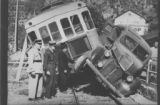
Motorized Rail car Renault against Ford car: no win!!! Courtesy GECP
I have already mentioned my Dad’s love for train and mass transportation in a previous article Live Steam - My Lifelong Hobby. My Dad’s theory is that the worst place to see a train is …when you are on the train ! Therefore, we would be in our family car driving from spot to spot and wait for the train to go by.
The track follows a section of the mighty river called Var. The Var has very scenic gorges. When it rains, it is not unusual that the river becomes wild and destroys the track. In 1994 the track was destroyed in 40 different spots including the Gueydan bridge . Since then, it was rebuilt by the French Military Corps of Engineers.
In 1935, the first self-powered railcars with diesel engines built by Renault appeared on the line.
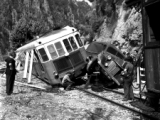
Accident with a self-powered rail car. Nice 1952 Photo
Paul Louis. Photo courtesy Collection Huffschmitt.
In 2010, diesel engines powered four daily trains servicing the different cities along the line. The current owner of the line, the Provence-Alps and French Riviera Region is investing significantly in the line, with new rolling equipments, new tracks, optimized schedules and an aggressive sales and marketing approach.
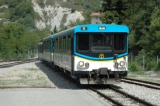
SY X301 coupled with rail car at the Annot station
The rolling stock is composed of:
- Seven self-powered railcars SY type with forty-eight seats each
- One reversible Soulé self-powered railcar with120 seats
- Four brand new self-powered railcars AMP. Some technical adjustments have delayed the usage of these cars. They will be on regular duties in 2011, just as the Nice – Digne line will celebrate its century!
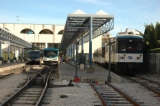
A rail car, the SY X304 and the reversible self-powered rail car at the Nice station
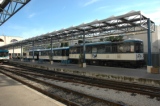
The reversible self-powered rail car at the Nice station, headed by engine # 62

SY X302 arriving at Entrevaux station, under thunderstorms
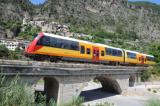
A new self-powered rail car CFD AMP 800 in test mode, driving by Touet, a Var town
More about the Provence Railway can be found at http://gecp.asso.fr/
Photo credits :
- Five self-powered diesel and train accident photos : Raphaël SANT / GECP
- Photos with GECP watermark: GECP
- Photo Paul Louis , accident self-powered rail car: Collection Huffschmitt
- Other photos by Philip Schram
Video Chemin de Fer de Provence
Previous page Next page


